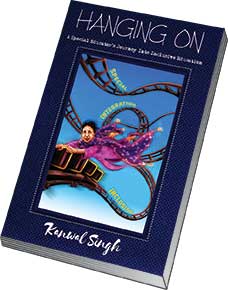Sheela Ramakrishnan
By the time I finished Kanwal’s book I was hanging on to everything desperately, lest I lose it completely! My four decade long career which contained big patches of spl ed (cringe to use that word now!), my sense of thinking that I knew something, all that sense of the nobility balloon that Kanwal so effortlessly bursts right in the beginning! By the time I finished, I was ready to both hide under the sofa and then after suitably licking my wounds, step out and use inclusion more consciously and banish spl ed from my vocabulary! Till now I was using both – not ashamed to admit it.
It is Kanwal’s inimitable style that holds the book together.
The conversational tone makes for interesting and gripping reading. It is almost as if Kanwal is sitting there with her legs on either side of the chair and giving all the readers a dressing down! But what is endearing is that she doesn’t talk down – she also is the recipient of what her readers experience. Each of her examples is realistic, true and absolutely a slice of the system – exposed as needed to be.
If there is one thing that makes the book unputdownable – it is the humour! Edward de Bono, the father of lateral thinking said humour and creativity spring from the same source. The author demonstrates this in ample doses to temper the depth of seriousness of the topic on which she writes. This could not have been easy for someone who is obviously so passionate about her vocation. It is refreshingly unconventionally outstanding!

The accompanying illustrations prevent the text from overloading the head – they do as much or more to talk as do the words. Simple but highly evocative drawings, tables, font sizes and styles, flow charts – the publishers have used every trick in the book to break the monotony of continuous text and to give life to Kanwal’s voice.
Kanwal asks a lot of uncomfortable questions that shake us out of the status quo and force us to think. A few samples as teasers:
• Do we want students with disabilities to be considered Special, Normal or Diverse?
• Does having a segregated section within a regular school mean we are practising Inclusion?
• Do we want to be safe in our Comfort Cocoon or drink the Truth potion and take Action? We have a choice.
Kanwal uses the Right to Education Act as the basis in its truest sense to argue for inclusive education in its truest sense too! She firmly believes that the more special we make this education, the less inclusive we are!
She breaks down jargons to the bare bone so that we see the truth, as is. It is passionately spiritual in its effort. When she decodes the special education activities and the feelings behind it – a practise she was also party to – it is evident that very deep thought and reflection have gone into the process. By her own admission, it took 5 years and 11 drafts to produce the 115 page book! It is easy therefore to understand the degree of turmoil that led to the intense conviction that rings through the book.
Though the book’s byline says it’s a Special Educator’s journey to Inclusive Education, by the time one has finished the book, one is left with the feeling that every single educator needs to read the book, as this is the key point that Kanwal makes. Inclusive education is for all – not just for those with disabilities, not just for high achievers – but for all children, without gender bias, without economic bias, without social bias, without ability bias, without language bias, without body type bias – without ANY BIAS. The moot question therefore that she raises is – can we adult educators, special or not special, build a society that accepts all without bias? For this we need to look deep inside our own selves and understand how our own biases creep into our vocation either by being too over kind or too under kind. That kind of eco system would be truly inclusive – Kanwal brought me there. It is a goal that is not just worthy to follow but a must do for all of us in the field of education. That was my greatest takeaway – let us all be not special, but inclusive in a very REAL way.
Arguably one of the most hard-hitting case for inclusion ever made so far that I have come across, by someone who has soiled her hands, learnt her lessons and unabashedly admits her own stumbles on her journey. Layer by layer, Kanwal peels the skins of evolution and destroys the halo. But she doesn’t just stop there.
In place of the halo that she took away, she places a crown on ALL teachers – to be responsible and be agents of change for inclusion. And for that, Kanwal deserves the largest crown of all!
If at all I had to pick a flaw, it would be the few typos cropping up here and there. They could be corrected in further prints.
The practicality of the process of inclusion suggested, the Rs – yes, it’s a long idealistic journey, but one that we MUST make as educators if we are to make an impact in the system.
Recommending the book with Herculean strength for every school and every educator!!
The author is an advisor to schools in school transformation, curriculum development and classroom methodology. She is the co-author of four series of textbooks published by the OUP, a certified ISO 21001 auditor, a counsellor and trained e-coach for students with anxiety from the Stanford School of Medicine and trained in creative thinking in the UK and activity based methods of teaching in Malaysia and Thailand. She can be reached at sheelaforlearn@gmail.com.
